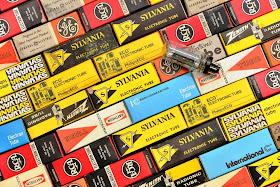This article covers another TV Damper tube: The 6DQ4. Although I covered already several different TV dampers, these are worthwhile the attention since they are fabulous for rectifier duty.
The 6DQ4 is pretty much identical to the 6AX4 electrically. Please refer to the 6AX4 Tube of the Month article of last year for the technical paramters and application of the tube in audio amplifier power supplies. In this article I will show the construction details of this tube.
Like most TV dampers, the 6DQ4 was manufactured by many different companies, here just a few brands:
The tube was made in a various different shapes:
Let's have a closer look at one with the small 'coin base':
The side with the getter on the glass:
In the next photo it can be seen that the plate is made of copper:
On the other side the ring can be seen which held the getter material before it got flashed and condensed on the glass as a silvery mirror:
A close up of the part between base and electrodes, which shows how they are connected to the pins:
The heater wire extending out of the cathode tube can be nicely seen, it is surrounded by a spiral of insulating material. The next photo shows a close up of the cathode at the other end of the tube:
The insulation spiral extends well beyond the cathode sleeve to ensure the very high heater to cathode voltage rating these tubes have. In the next picture the heater wire inside can be seen:
Let's have a closer look at the cathode. Here the cathode is removed from the plate and the heater wire is pulled out:
A close up of the top end of the cathode. The coated white part is the actual emissive area:
A peek inside the cathode from the bottom:
The heater:
A close up:
A close up photo of the plate structure:
Looking into the plate opening from the top:
The copper plate, opened up:
This is how the cathode would be placed inside the plate. Of course in a working tube the cathode would be held in place by the top and bottom mica supports, to ensure correct distance:
The construction of this tube might not be as impressive as that of the EC8020 which I presented last month. But still a remarkable piece of vacuum tube technology!
Luckily TV damper tubes are still available in abundance at low prices. Occasionally they can be found in bulk packs:
I hope you enjoyed this Tube of the Month article. As a last goodie a close up picture of a 6DQ4 shot in the dark with the tube turned on:
Best regards
Thomas


























Hello Thomas,
ReplyDeleteThank you for the excellent and informative articles about the various TV damper diodes you have used.
I have question for you; I intend to use a single damper diode after the mercury vapor rectifier tubes in the plate supplies of my homebrew SE DHT amplifiers, so as to provide a graceful turn-on of plate voltage to the tubes, etc.. I have narrowed the selection down to either the 6AX4 or the 6DA4. The voltage drop vs. load current for both of these damper diode tubes is very similar, but my question to you is this; which of these two tubes has the longer ramp-up time to full conduction? Ideally, I would like to use a tube with a relatively long ramp-up time.
Thanks for your time.
Best Regards,
check the data sheets or better yet as these tubes are cheap: Test it. But keep in mind it may vary from brand to brand
Delete